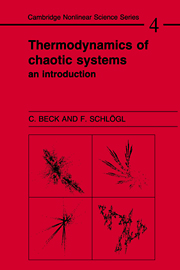Book contents
- Frontmatter
- Contents
- Preface
- Introduction
- PART I ESSENTIALS OF NONLINEAR DYNAMICS
- PART II ESSENTIALS OF INFORMATION THEORY AND THERMODYNAMICS
- 4 The Shannon information
- 5 Further information measures
- 6 Generalized canonical distributions
- 7 The fundamental thermodynamic relations
- 8 Spin systems
- PART III THERMOSTATISTICS OF MULTIFRACTALS
- PART IV DYNAMICAL ANALYSIS OF CHAOTIC SYSTEMS
- PART V ADVANCED THERMODYNAMICS
- References
- Index
8 - Spin systems
Published online by Cambridge University Press: 14 September 2009
- Frontmatter
- Contents
- Preface
- Introduction
- PART I ESSENTIALS OF NONLINEAR DYNAMICS
- PART II ESSENTIALS OF INFORMATION THEORY AND THERMODYNAMICS
- 4 The Shannon information
- 5 Further information measures
- 6 Generalized canonical distributions
- 7 The fundamental thermodynamic relations
- 8 Spin systems
- PART III THERMOSTATISTICS OF MULTIFRACTALS
- PART IV DYNAMICAL ANALYSIS OF CHAOTIC SYSTEMS
- PART V ADVANCED THERMODYNAMICS
- References
- Index
Summary
We present a short introduction to various types of spin models commonly used in statistical mechanics. Different types of interactions are discussed, and we report on some of the known results on the possibility of phase transitions for spin systems with a certain interaction. The equivalence between symbolic stochastic processes and one-dimensional spin systems is elucidated. Finally we present a short introduction to the transfer matrix method.
Various types of spin models
A ferromagnet can be regarded as a system of a large number of elementary magnets that are placed at the sites of a crystal lattice. To model and understand the magnetic properties of solids, various types of lattice spin models have been introduced in statistical mechanics. Such a model of a spin system is defined by the lattice type, the possible values of the spins at each lattice site, and the interaction between the spins.
In this context the name ‘spin’ is used in quite a general sense: the spin is a random variable with certain possible values. These may be either discrete or continuous; moreover, in this generalized sense, the spin can be a scalar, vector, or tensor. Also the lattice, originally introduced to model the crystal structure of the solid, sometimes does not possess a physical realization in nature.
Quite common choices of lattice structures are cubic, triangular, or hexagonal lattices in dimensions d = 1, 2, 3, 4,… But one also studies so called hierarchical lattices, which have a self-similar structure.
- Type
- Chapter
- Information
- Thermodynamics of Chaotic SystemsAn Introduction, pp. 78 - 87Publisher: Cambridge University PressPrint publication year: 1993

